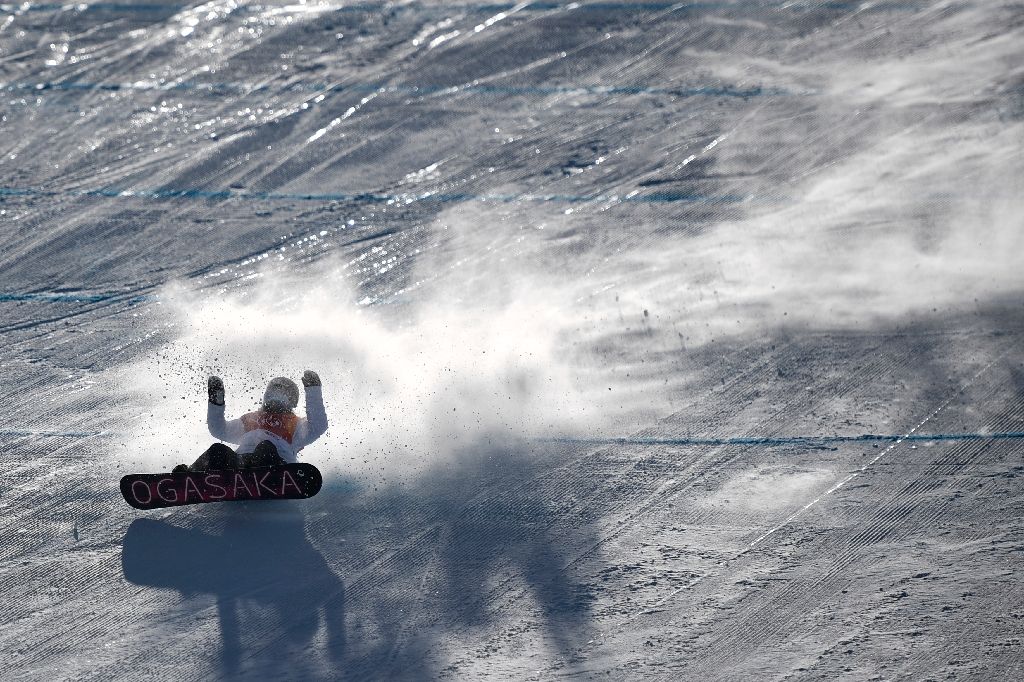
These aren’t just fun and games.
Oh, it’s easy to think that, lulled by the style and flair with which snowboarders and aerial skiers do their tricks. Or the speeds produced by skiers, lugers and skeleton racers. Make no mistake, however. What athletes in several Winter Olympic sports do could kill them.
No hyperbole, no exaggeration. Literally kill them.
This weekend was a blunt reminder of that. Gale-force winds forced two Alpine skiing events to be rescheduled, and should have caused the women’s slopestyle finals Sunday to be postponed. Riders were being blown sideways while flipping and twisting 20-plus feet in the air. That no one was seriously injured – or worse – was a matter of sheer luck.
“I’m glad that on that last jump that I walked away from it,” Britain’s Aimee Fuller said. “Once you’ve taken off the jump, you’re in the air and it is what it is and you’ve then got to recover it. I thought I was fine and then as I came around I felt this absolute — it literally took me off my feet.”
Heart attacks and congenital defects aside, sports are generally not life-threatening. Scan the program for the Summer Olympics, and there’s very little that would petrify anyone’s mother. There’s some danger in gymnastics, equestrian and cycling, yes, where the wrong moves could land you on your head or your back.
But there’s no fear of an Olympic swimmer drowning during a race. Or a basketball player suffering a closed-head injury during a game. Or a sprinter shattering multiple bones or lacerating his or her spleen during the 100 meters.
In the Winter Olympics, however, skiers, snowboarders, bobsledders, lugers and skeleton racers — they all flirt with death every time they take a run.
Eight years ago, Georgian luger Nodar Kumaritashvili was killed when he lost control of his sled and was thrown headfirst into a pole during a training run at the Vancouver Olympics. He was going almost 90 mph when he crashed.
Sarah Burke, a freeskiing pioneer who helped bring halfpipe skiing to the Olympics, died after she crashed at the bottom of a pipe during training in January 2012. It was the same pipe where Vancouver medal favorite Kevin Pearce suffered a traumatic brain injury a few weeks before the 2010 Olympics.
Three months ago, French Alpine skier David Poisson died after hitting a tree while training for World Cup races he hoped would earn him a spot in Pyeongchang. Shaun White still has stitches in his tongue after slamming his face on the lip of the halfpipe in late October while training in New Zealand.
“I scared myself,” White said in a video of the crash posted last month. “I haven’t really had that much blood coming out of me before.”
And Canada’s Mark McMorris won the bronze medal in men’s slopestyle Sunday – less than a year after rupturing his spleen and breaking his jaw, left arm, pelvis and several ribs when he hit a tree. That accident came 11 months after he broke his femur in another snowboarding crash.
“I’m just really looking forward to riding my snowboard and going in the backcountry because I’ve missed two years of that, doing the fun side for me,” McMorris said. “I’ve been pretty stuck in the contest scene for a while.
“Or a death bed.”
Athletes in high-risk sports accept that there’s an inherent danger in what they do. But that doesn’t mean they have a death wish. They control what they can and, particularly at this point in their careers, back off when they encounter conditions that are too dangerous.
Like winds so strong they blow people over.
“We can actually get super hurt and it’s just really unfair,” said slopestyler Silje Norendal of Norway, who broke her arm in similar conditions during last year’s test event.
“To be honest, I didn’t get through the course once in practice. I hated it,” Norendal said. “All I wanted to do was sit up top and cry.”
The International Ski Federation defended its decision to go ahead with the women’s slopestyle event, saying the weather was “stable enough” to proceed. While acknowledging the many complaints from athletes, the FIS said “the nature of outdoor sports also requires adapting to the elements.”
Adapting to the elements means breaking out an umbrella when it rains or adding an extra layer to ward off the cold.
Not risking a broken neck.
For some Winter Olympians, there’s a chance of dying anytime they compete. Olympic officials don’t need to shorten their odds.
By Nancy Armour
This article was republished with permission from the original author and 2015 Ronald Reagan Media Award recipient, Nancy Armour, and the original publisher, USA Today. Follow columnist Nancy Armour on Twitter @nrarmour.
Rachel Axon contributed to this report.